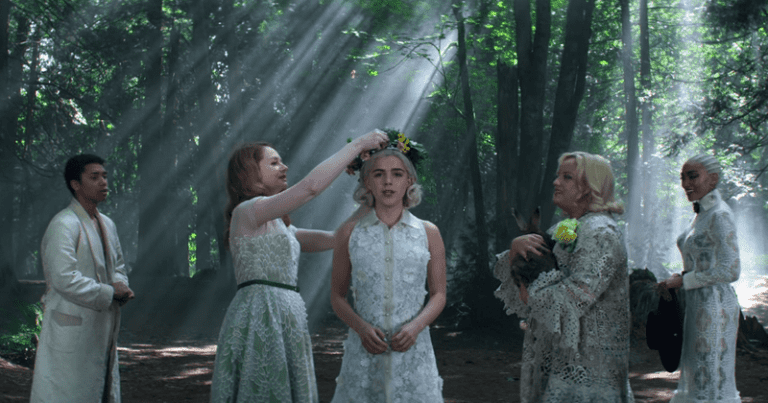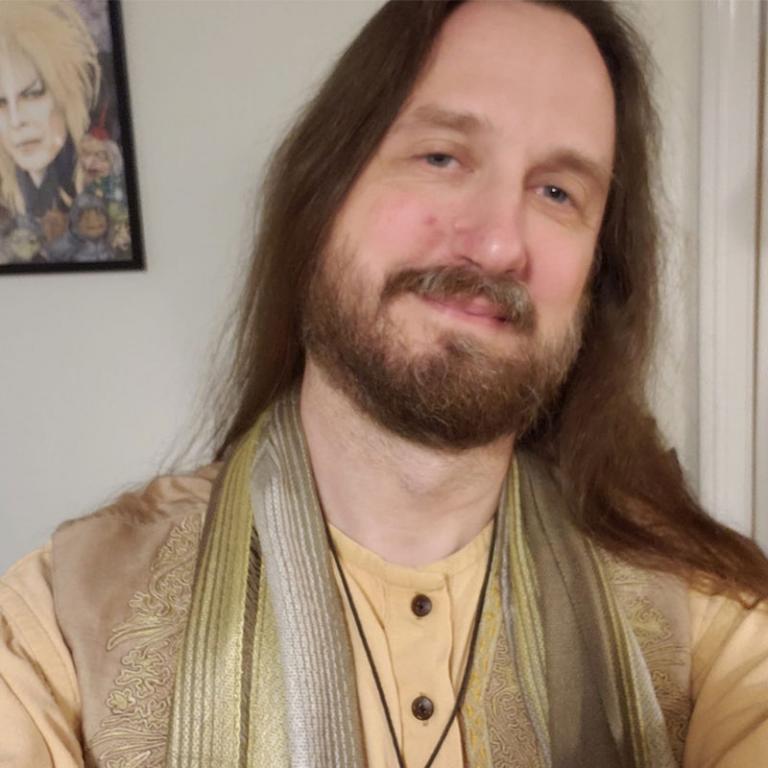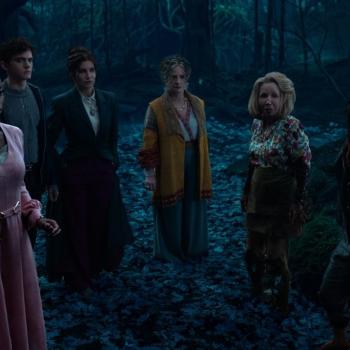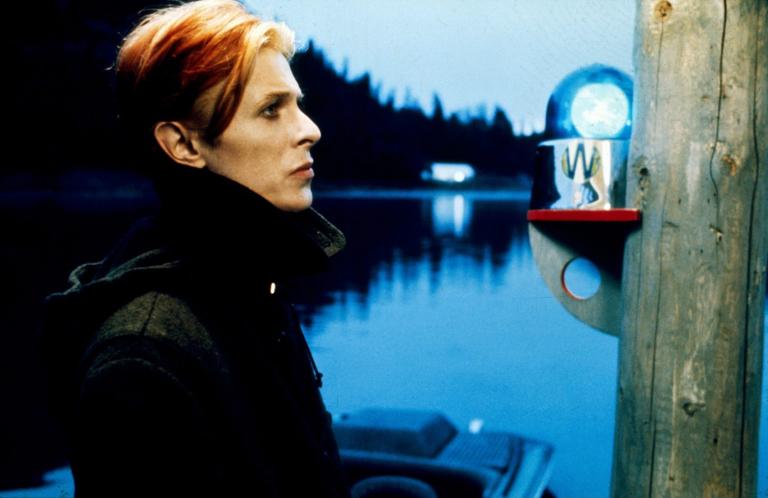This past year has certainly been a time for folks to look to the otherworldly, and the fictional media of 2020 was no exception. We’ll be looking at 10 key occult films and tv shows of 2020. While some entries here are sequels, re-imaginings, remakes and continuations – and in some cases, conclusions – of various television series, we also have some of the most innovative work with occult themes we’ve seen in some time.
With one notable exception (the final episodes of “Supernatural”), these entries were all filmed and completed before the pandemic, so for the most part, the shows didn’t necessarily address what we went through in 2020. However, “Lovecraft Country” in particular was reflective of the summer unrest and protests around George Floyd, Jacob Blake and Black Lives Matter, which are of course, ongoing issues.
So here is my top 10 list of occult films and tv shows, focusing on themes of witchcraft, magic, and occultism.

10. The Witches (released October 2020, Warner Brothers Pictures, HBO MAX).
Robert Zemeckis’ bloodless remake of Nicholas Roeg’s bizarre 1990 cult film is mostly run of the mill stuff, with standard bland CGI effects replacing the grotesqueries of Jim Henson’s Creature Shop in the original. However, its reframing of the story to the Civil Rights Era of the American South, casting Chris Rock as the narrator, does lend to some mildly intriguing cultural commentary. Rather than a Norwegian witch hunter grandma and her precocious American grandson up against a Germanic high witch, we have a Black Southern grandma (Octavia Spencer) and her precocious grandson up against a vaguely Scandinavian high witch (Anne Hathaway).
The difference here is that grandma is a hoodoo practitioner on the downlow. In a brief scene, we see Spencer literally in the broom closet throwing bones and mixing herbs and Chris Rock, narrating as the older version of the grandson proclaims “I was starting to think grandma was a voodoo priestess!” Of course, confusing hoodoo and voodoo isn’t surprising for a light hearted kids movie, that nonetheless retains the darker ending of the Roald Dahl short story, unlike the much creepier 1990 film.
The film’s change in time and locale also offers a reframing of witchcraft folklore from the cautionary Scandinavian tales of the original to the cautionary tales specific to southern rural Black culture, with a warning against “lollygagging.”
Given that both films, and Dahl’s story, are based primarily on folklore, and not on actual witchcraft, it is notable that, rather than the accusations of misogyny tied to the original (which have since been reconsidered), or any protest from actual witches, the main controversy that emerged over Zemeckis’ remake is the portrayal of witches as having “limb difference.” So much so that Anne Hathaway issued a very clear, public apology.
Given that Hollywood has a long history of portraying villains with disabilities and witchcraft in history is rife with stories of disabilities being the mark of something sinister, as the sign of a witch or fairy changeling, it’s not surprising that Zemeckis’ remake would go this route. It remains to be seen if that trope will be abandoned after this public controversy.

9. The Craft: Legacy (released October 2020, Blumhouse Productions).
The 90s media witch nostalgia continues in this remake/sequel of the dubious cult film that holds such a prominent place for Millennial witches. Critics and fans were both sharply divided here, with many dismissing the film as “woke trash” while others praised the film for updating and improving on the original’s problematic tropes about women destructively coming into power.
While the original leaned more towards light horror, featuring the young women magically attacking each other, and was entirely written, directed and produced by men, “The Craft: Legacy” had a different pedigree. Zoe-Lister Jones was the writer and director of this version and, in an interview in Vanity Fair, tells us that her intention was to remind viewers that “there is no power too great for women to harness and that we always need to be wary of turning that power on each other.”
Indeed, the villain in “The Craft: Legacy” is toxic masculinity, represented most specifically by David Duchovny’s abrasive Jordan Peterson-esque character. And while this is a fascinating shift in the narrative, it unfortunately sidelines the young witches, to the degree that their characters come off as thinly written tokens. This is particularly disappointing given that the film’s ads so prominently highlight the Black and trans Latina actresses in the supporting roles. In the original, the focus was on the four young witches, whereas in the sequel, the main relationships are within the internal family dynamics of the main character, Lily (Cailee Spaeny).
From a magickal standpoint, the tone of the sequel is also in marked contrast with the original, which presented ritual magic as somewhat scary and forbidden, despite taking actual elements from the Gardnerian liturgy. In this version, magic is presented as no more out of the ordinary than an Instagram filter and instead of causing violence or cursing, it involves increasing wokeness and wardrobe changes, with the magic often taking the form of random superpowers. In one notable scene, for instance, an anti-gay bully is shamed when the witches turn his jacket into a rainbow design.
While the original did have a Pagan consultant, “The Craft: Legacy” boasts three, including author, blogger and podcaster Pam Grossman, who designed the spells and rituals for the movie. And while the magic was meant to be less threatening and more socially responsible, issues of consent remain a problem, as demonstrated by the wokeness spell cast on one of the main male characters, which involves a used condom as one of the icky ingredients. And that’s not even getting into the messy politics of that character coming out as bi before he is killed offscreen. Fellow Patheos blogger Lilith Dorsey discuss some of the problematic aspects of the film on our YouTube program, The Pop Occulture Show!

8. Legends of Tomorrow/Doom Patrol (DC television).
For number 8 on my list, I’ve included these two DC superhero shows, “Legends of Tomorrow” on the CW and “Doom Patrol” on HBOMAX, primarily for their use of occult magician characters, the incomparable John Constantine (Matt Ryan) and Willoughby Kipling (Mark Sheppard, who occult tv fans know as Crowley from “Supernatural”).
While Keanu Reeves is rumored to reprise his movie role as the Americanized Constantine in a future “Justice League Dark” film, Welshman Matt Ryan owns the character, taking the working class Liverpudlian occultist on an unlikely journey from his short-lived 2014 NBC show into some appearances on “Arrow” and then finally as a regular on the CW’s secret weapon, the hilarious metafest “Legends of Tomorrow.”
And while it’s odd that the infamously nicotine-addicted character from the Hellblazer comics can’t manage to light a cigarette on the CW, and true Constantine fans long to see some of his more adult, horrific stories adapted, the trenchcoat trickster fits right into the wackiness of “Legends.” Indeed, he had a central role in last season’s shenanigans along with the Arrowverse version of Astra , one of his great tragedies from the comics.
Playing a more minor role in the even weirder “Doom Patrol,” Sheppard’s world weary Willoughby Kipling is intentionally a poor man’s Constantine – in fact, Grant Morrison created the character for his well known run in the Doom Patrol comics in the early 90s, because he wasn’t allowed to use Constantine.
Sheppard had a bit more to do in Doom Patrol’s second season, truncated by one episode due to the coronavirus. Kipling is a bizarre character who can create magical portals with a cigarette and seems to be in love with a blue horse head spirit that he is able to conjure (with the unlikely name of “Baphomet” presumably unrelated to the big horned one familiar to occultists).

7. The Order (Season 2, Netflix, released June 2020).
The second season of the Canadian Netflix show about pretty young occultists vs pretty young werewolves (who are also, kinda, occultists?) was a vast improvement over the sluggish 1st season with much less angst and melodrama and more fun and queer content (almost everyone is sorta bi now?).
The second season storyline features a somewhat underdeveloped but still intriguing plot about anarchist activist magicians working against the elitist initiates of the titular Order of the Blue Rose. And they double down on the occult material with old school Solomonic demonology, including an actual mention and appearance of the Sworn Book of Honorius.
Part of the fun of the show has always been “spot the recognizable Canadians” (there’s Todd from “The Magicians”! There’s Dorian from “Sabrina”! There’s Kaylee from “Firefly”! There’s Matt Frewer from…everything!). This season we get James Marsters (Spike from “Buffy”) in an understated role in two episodes and hilarious cameos from Ian Ziering and Jason Priestley of “90210” as themselves. You never know who’s in a secret occult order!
Unfortunately, just as the show started getting good, Netflix brought down the ax and cancelled “The Order” after two seasons.

6. His Dark Materials (Season 2, HBO, released November 2020).
The BBC/HBO joint adaptation of Philip Pullman’s subversive children’s fantasy trilogy just completed its second season, focusing on the second book, “The Subtle Knife.” Given the context of the story (and I confess I never did get around to reading the books – someday!) it seems that the “subtle” in the title is an alchemical reference, as in “Separate the earth from the fire, the subtle from the gross, acting prudently and with judgment” from the Emerald Tablet.
Of course, this sprawling narrative has a little bit of everything for the occult fan – symbol based divination (from the alethiometer, the “Golden Compass” of the first book’s title), shamanism, totemism (with the fascinating concept of daemons and their connection to the humans’ souls), witches who have a connection to the earth, with tree branches embedded in their bodies and the ability to fly and turn into mist, and angels who speak through dark matter and can be reached using the I-Ching.
At the heart of Pullman’s narrative, however, is the fight between personal freedom and the authority of, well, the Authority, the God that the oppressive Magisterium uses to control the masses. When first watching the show I saw it as a cross between “Harry Potter” and “The Handmaid’s Tale” and that comparison seems to have been borne out.
Ultimately, though, despite its occult trappings, this story is purely Biblical in its thrust, but written from the perspective that God is the oppressor and Lyra is the heroine Eve (she’s even called that in a “prophecy”) bringing humanity free will and knowledge.
Season 3, the show’s final season based on the third book of the trilogy, “The Amber Spyglass” is ramping up production soon.

5. Supernatural (CW network, final episodes aired October-November 2020).
Oh, Supernatural. I couldn’t quit you if I tried. I’ve been with this show from its beginnings, all the way back in 2005, when I was still using a VCR and stuck with it, even when it was just out of sheer habit, in the low years of season 7 or so. It’s literally been in my life as long as my teenage daughter.
I confess that in the last few seasons, my love for the show was re-kindled, after they brought back Mary Winchester, and finally leaned into their female and queer fandom, rather than mocking it. And absolutely embracing the fact that macho Dean Winchester is in fact, a giant nerd. Indeed, the Supernatural cult of fans could be said to be at the vanguard of geek culture for many years and the show did not disappoint in stirring up controversy in its final episodes. At least, I think there was controversy – I can’t be sure since I spent those episodes mostly bawling like a baby.
As far as occult content goes, yes, there are magical spells and macguffins, deals and betrayals, and an odd resolution in which Jack, the son of Lucifer (so…the antichrist, right?) becomes the new God after the old one, the narcissistic would-be novelist Chuck, loses his power. After his transformation, Jack basically paraphrases the apocryphal Gospel of Thomas, which states “Split a wooden stick and I am there and lift a stone and you shall find me.” Or maybe they were just ripping off “Stigmata.”
Regardless, farewell Supernatural, it’s been a long, wild 15-year ride. If you’d like to hear more discussion about the Supernatural finale check out our conversation with super fan, Mary Sue author and podcaster, Jessica Mason on “The Pop Occulture Show.”

4. The Chilling Adventures of Sabrina (Netflix, part 3 released January 2020).
Anticipating the drop of the final episodes of Sabrina on New Years Eve, I can’t help but note how the show is the perfect occulture artifact to savor – full of delicious stories, characters, magic and rituals, plus Hammer horror, macabre fiction, and occult comic book references galore. I’ll be writing about the final episodes and the show as a whole next week, but let’s take a look at the previous season, in which “Pagans” were the baddies.
One of the things I’ve always found delightful about “Chilling Adventures” is its uniqueness in representing a functioning magickal community that actually takes into account organized religion. Granted, it’s not a great religion, being that it’s Satanic and all that, but the show goes to great lengths to display cultural norms and structures, even down to the language (“what the heaven?”), which is something you don’t see very often in shows that depict occultism.
As a Pagan viewer, I admit that I chuckled every time the show’s characters complained about those “damn Pagans.” Functioning like a cross between characters from Something Wicked This Way Comes and Wicker Man, these Pagans are old world, European, “other,” and their mission is to return the earth to the Green Man, destroying the humans. Now that’s some extreme environmental activism!
There are also definitely some class issues at work here, as the Pagans are clearly presented as lower class (no one uses the G word, but the Roma implication is there). This quite definitely contrasts with the upper middle class New England Protestant (except, you know, Satanic) nature of the comfy suburban main characters with their elaborate funeral home/mansions.
The witches are struggling with their identity, as they’ve left behind Lucifer as their sole master, then try on Lilith for size and ultimately reject her as well, eventually settling on a particular form of left-hand path goddess worship focused on the moon and Hecate. I’m curious to see where this worship winds up in the final season as the Lovecraftian “eldritch horrors” are introduced.

3. Gretel and Hansel: A Grim Fairy Tale (Orion Pictures, released January 2020).
One of my favorite things to do on a winter night is watch a little bit of unsettling folk horror. This particular version of the classic fairy tale from director and co-writer Oz Perkins (along with Rob Hayes) makes some fascinating moves in its re-interpretation.
Taking its cues from “The Witch” (2015), with its stylized dialogue, claustrophobic camera work and eerie forest settings, “Gretel and Hansel” adds surrealistic lighting and shadows and an odd – but strangely successful – electronic soundtrack. But of course, the film hinges on the stellar performances of its lead, the fantastic Sophia Lillis, and the Borg Queen herself, Alice Krige, as the Witch.
Here, despite the clear children-eating, the Witch herself is an intriguing character with her motivations around Gretel ambiguous at times, until it becomes clear that she wants a protégé. Teaching Gretel herbology, dream work and meditation. At the beginning, we see Gretel herself resistant to what her repressive society has lain out for her and her struggles with being her younger brother’s caretaker. So we know that she is receptive to the witch’s independence and self-reliance.
Unlike its stylistic predecessor, the Robert Eggers’ “The Witch,” there is no Satan here, no Black Phillip, no tempting force other than women’s power and connection to the earth. The only Satanic indication is an unexplained upside down pentagram carved in a tree (which could easily have been a ward). When we see a younger version of the Witch, she’s basically an anachronistic goth gal covered in occult tattoos.
But ultimately, at the heart of the film is the notion of story. Without being too heavy-handed, Gretel wonders what story she will lead and we eventually see that what we thought was the origin story of the witch, the girl with the pink cap, is not quite what we thought it was. And Gretel is left at the end of the film with the decision of how to wield her power.
If you haven’t seen this little gem, I highly recommend it.

2. The Magicians (SyFy Channel, Final season aired January-April 2020).
Probably one of my favorite shows focused on magic EVER, “The Magicians,” based on a series of novels by Lev Grossman, ended its 5 year run this past Spring. While I confess I haven’t seen the final season (hey, I’m a cord-cutter and it will arrive on Netflix on January 15), I can’t imagine I could love the show any more.
Where else can you get so many charismatic, funny and sexy characters doing magick with choreographed tutting? Where else can you get fantastic musical renditions of pop songs that integrate emotional character and plot moments, like this or this, or (sob!) THIS.
Whether it’s the adult version of Narnia with creepy invisible Fairies and horny fauns or the camaraderie and family tensions of the impossibly attractive main cast, “The Magicians” has always been a thrilling, stimulating ride that doesn’t shy away from disturbing and controversial topics.
I’ll write more about this when the final season airs on Netflix in a few weeks, but let’s just say I can’t wait to see more of Eliot and Margo and the gang.

1. Lovecraft Country (HBO, season 1 aired August-October 2020).
In 2020, no other occult-themed property even comes close to the majesty of “Lovecraft Country.” Based on Matt Ruff’s 2016 novel, which itself emerged from a cultural shift which began addressing the ugly racism of H.P. Lovecraft’s legacy, the HBO show challenges its viewers to confront our nation’s racist past and present, through the lens of occultism. Yet it also promises a brighter future for Black America.
The show casts its spell on so many levels, and I can’t possibly do it justice in the small space I have here, but there are a few things I’d like to unpack. First, what the show does so well, particularly in its televised medium, is perform a kind of meta-magick itself with its approach to chronology.
While the writers, led by showrunner Misha Green, didn’t necessarily break new ground with anachronistic soundtrack choices, like playing Bananarama’s “Cruel Summer” over Emmett Till’s funeral, but the show takes it a step further by consistently running audio from different time periods over crucial scenes.
The first of these poignant sequences is James Baldwin’s “what is reality” speech from his historic debate with William F. Buckley at Cambridge in 1965, played over ominous scenes of main characters Tic (Jonathan Majors), Leti (Jurnee Smollett) and George (Courtney B. Vance) navigating a sundown town in the Northeast, set over a decade earlier.
This repeats in the second episode, where Gil Scott-Heron’s 1970 spoken-word piece “Whitey on the Moon” – also the name of the episode – plays over the climactic scene in which The Order of the Ancient Dawn attempt to sacrifice Tic. And again, when young Naomi Wadler’s 2018 March for Our Lives speech plays over the harrowing scene in which the teen Diana (Jada Harris) is pursued by horrific versions of Topsy and Bopsy from “Uncle Tom’s Cabin.”
These are just a few examples of instances where the show leans into its themes of racism and generational trauma, telling viewers that all time is simultaneous and the chaos magick of Black voices throughout history can help embody the story being told.
In a way, the show is borrowing one of Lovecraft’s own methods, the creation of meta-texts, such as the Necronomicon, and asking other authors to play in the worlds that he created. In this, Lovecraft himself, though a materialist, borrowed from occult traditions that built entire followings based on fictional texts that were treated as if they were real, such as the Rosicrucian manifestoes or the Golden Dawn cipher manuscripts.
This kind of occult borrowing is also weaved into the story of the show itself, as the main character, Atticus Freeman learns the language of Adam and the spells of the White magickal order that he belongs to by blood (in other words, his ancestor was a servant who was raped by the head of the Order). Throughout the show, other characters, such as the fierce Leti and his father, the abusive but protective Montrose (Michael K. Williams), question Tic’s use of this magic, essentially presenting the argument that you can’t tear down the Master’s House with the Master’s Tools.
But in “Lovecraft Country,” that’s exactly what Tic and his extended family do, turning the White oppressor’s tools of magic against him through the power of family connection and ancestors who help beyond the grave.
I’m barely scratching the surface of all the ways the show presents and critiques magic, from the problematic nature of Christina’s (Abbey Lee) spells and her own quest for power grounded in body horror and her tendency to whitesplain magic, to the way that the show interrogates Christian charismatic practices along with African traditional religions (and some ATR practitioners have objected to the show’s mishmash of traditions in the “Holy Ghost” episode), to the story’s final powerful consequence of binding White people from magic,
All I can say is that if you haven’t watched it, I can’t recommend it highly enough. Watch Lilith Dorsey and I discuss Lovecraft Country on The Pop Occulture Show!
This wasn’t an exhaustive list – I wanted to mention Lucifer or Legacies, as well as other programs I haven’t seen yet, such as Motherland: Fort Salem, or Alan Moore’s Twin Peaks-esque The Show, which I don’t believe is available in the US yet.
What were your 2020 favorites? What are you looking forward to in 2021? Let me know in the comments!


















